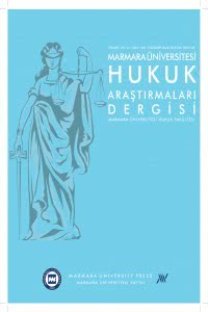Halk Tarafından Seçilen Cumhurbaşkanı'nın Siyasal Rejime Etkisi (Avusturya Örneği)
İlk kez Birleşik Krallık’ta ortaya çıkan parlamenter rejim, zaman içinde gelişimini sürdürmüş ve çoğu demokratik ülke tarafından kendi siyasal sistemleri doğrultusunda çeşitli değişikliklere uğrayarak kullanılmaya devam edilmiştir. Öte yandan Cumhurbaşkanı’nın doğrudan belirlendiği ve ona özgün geniş bir yetki alanının yaratıldığı yarı-başkanlık rejimleri, 20. Yüzyılın sonlarından itibaren bir çok Avrupa ülkesinde hızla yayılmaya başlamıştır. Ancak günümüzde hala yarı-başkanlık ve parlamenter rejim ayrımı konusunda tam bir oydaşma sağlanamamaktadır. Bu sorunun temelinde, halk tarafından seçilen Cumhurbaşkanı’nın tek başına parlamenter rejimi yarı-başkanlığa dönüştürüp dönüştürmediği sorunsalı yer almaktadır. Çalışmamızda, ilk önce yarı-başkanlık ve parlamenter rejim konusunda siyasal öğretide ortaya çıkan tartışmalar değerlendirilecek, sonrasında bu teorik değerlendirmeler, Cumhurbaşkanlarının yetkilerinin ölçümü doğrultusunda Avusturya örneği üzerinden çözüme kavuşturulacaktır. ABSTRACT The parliamentarism that first appeared in the United Kingdom, carried on growing in time and continued to be used with some changes according to their political system by a lot of democratic country. On the other side semipresidential regimes in which President is determined directly and given a wide range of power specific to him, started to spread rapidly in a lot of European countries as of late 20th century. Today there is still no consensus between the discrimination of semipresidential regimes and parliamentiarism. The basis of this problem is that the problematic of the popular elected President’s turning the parliamentiarism into semipresidential regimes. In this study, at first the arguments which appeared on political literature about the semipresidential regimes and parliamentiarism will be evaluated, and then this theoric evaluations will be solved on measurement of President’s power based on Austria example.
Anahtar Kelimeler:
Cumhurbaşkanı'nın halk tarafından seçimi, Cumhurbaşkanı'nın yetkilerinin ölçümü, Cumhurbaşkanı'nın yasama-dışı yetkileri, siyasal rejim türü
___
- Democracy Reporting Intematioml,Systems of Government: Semi-Presidential Model, Briefing Paper, No. 27, March 2012, s.5.
- DUVERGER, M, “A new political system model: Semi-presidential government.” European Journal of Political Research 8, 1980, p. 165-187.
- ELGIE, Robert, “Duverger Semi-presidentialism And The Supposed French Arc- hetype.”, West European Politics, Vol. 32, No. 2, 2009.
- ELGIE, Robert, Semi-Presidentialism Sub-Types and Democratic Performance, New York: Oxford University Press , 2011.
- ELGIE, Robert, “The Politics of Semi-Presidentialism”, ELGIE, Robert (eds.) in Comparative European Politics Semi Presidentialism in Europe 13, 1999.
- ELGIE, Robert, “Three waves of semi-presidential studies.”, Democratization, Vol. 23, No.1, 2015, p. 49-70.
- GARRIDO, Antonio, "Semi-Presidentialism and Democracy: A Comparative Pers- pective", AWorld Congress of the International Political Science Association , IPSA Santiago de Chile, 2009 .
- KOKER, Philipp, Veto et Peto: Patterns of Presidential Activism in Central and Eastern Europe, Thesis, University College London, 2015.
- LOUWERSE, Tom, “Unpacking positive and negative parliamentarism”, in work- shop “The Evolution of Parliamentarism and Its Political Consequences” of the European Consortium of Political Research, 2014, p. 10-15.
- MARTINEZ, Rafael Mart’nez, “Semi-presidentialism: a comparative study”, in pre- sentation at the ECPR Joint Sessions of Workshops, Mannheim, 1999, p. 26-31.
- METCALF, Lee Kendall, “Measuring presidential power. Comparative Political Stu- dies”, Vol. 33, No:5, 2000, p. 660-685.
- MÜLLER, Wolfgang C, “Austria”, ELGIE, Robert (eds.) in Comparative European Politics Semi Presidentialism in Europe 13, 1999.
- MÜLLER, Wolfgang C, “Austrian Governmental Institutions: Do They Matter?”, West European Politics, Vol. 15, No. 1, 1992, p. 99-131.
- ÖZSOY BOYUNSUZ, Şule, Başkanlı Parlamenter Sistem: Cumhurbaşkanının Halk Tarafından Seçildiği Parlamenter Hükümet Modeli ve Türkiye için Tavsiye Edilebilirliği, 2. Baskı, İstanbul: On İki Levha Yay, 2014.
- ROSANI, Domenico, The Head of State in Austria, Italy, The Netherlands: A Brief Comparative Study. 2014.
- SHEN, Yu-chung, “Evolution of Semi-Presidentialism: Toward a Quasi-Parlia- mentary or a Quasi-Presidential System?”, http://paperroom.ipsa.org/papers/pa- per_26149.pdf, Erişim Tarihi: 23.4.2016.
- SHEN, Yu-chung, “The Anomaly of the Weimar Republic’s Semi-Presidential Cons- titution”, Journal of Politics and Law, Vol. 2, No.3, 2009, s.35-43.
- SHUGART, Matthew Soberg, “Comparative executive-legislative relations: Hie- rarchies vs. transactions in constitutional design.”, University of California, Irvi- ne, Center for the Study of Democracy, 2005.
- SHUGART, Matthew Soberg; CAREY, John M, Presidents and assemblies: Consti- tutional design and electoral Dynamics, Cambridge University Press, 1992.
- SIAROFF, Alan, “Comparative presidencies: The inadequacy of the presidential, semi-presidential and parliamentary distinction.”, European journal of political research, Vol.42, N.3, 2003, p. 287-312.
- STROM, Kaare, Wolfgang C. MÜLLER, Torbjörn BERGMAN, Delegation and Ac- countability in Parliamentary Democracies, Oxford University Press, 2006.
- WU, Yu-shan, “Semi-Presidentialism and Nascent Democracies as a Research Agen- da.”, in the World Congress of International Political Science Association, Fu- kuoka, July. 2006.
- “Austria - Green candidate Van der Bellen beats far-right Hofer in repeat of runoff election”, http://presidentialactivism.com/2016/12/07/austria-green-candidate- van-der-bellen-beats-far-right-hofer-in-repeat-of-runoff-election/, Erişim Tarihi: 15.12.2016.
- “Austria - Will the April presidential elections bring an end to the SPÖ-ÖVP dominance of federal.” http://presidential-power.com/?p=4686, Erişim Tarihi: 17.12.2016.
- “Austrian Chancellor, Werner Faymann, Resigns as Right Wing Rises”, https://www. nytimes.com/2016/05/10/world/europe/austrian-chancellor-werner-faymann-re- sign.html?_r=0, Erişim Tarihi: 22.12.2016.
- “Freedom in the World 2015”, https://freedomhouse.org/report/freedom-world/ freedom-world-2015#.WIafc_mLTIW, Erişim Tarihi: 5.12.2016.
- “Presidential power and the Austrian presidential election”, http://presidential-po- wer.com/?p=5661, Erişim Tarihi: 17.11.2016.
- “Silencing the Messenger: Communication Apps Under Pressure”, https://freedom- house.org/report/freedom-net/freedom-net-2016, Erişim Tarihi: 5.11.2016.
- “The Federal Chancellor”, http://www.austria.org/the-federal-chancellor/, Erişim Tarihi: 17.1.2016.
- “The Political System: Parliamentary Democracy”. http://www.austria.org/parlia- mentary-democracy/ , Erişim Tarihi: 7.12.2016.
- “Was Austria’s presidential election really a vote against populism?”, The Lon- don School of Economics and Political Science, http://blogs.lse.ac.uk/eu- roppblog/2016/12/14/austria-presidential-election-populism/, Erişim Tarihi: 6.11.2016.
- “When should we start to consider a country as semipresidential?”, http://www.se- mipresidentialism.com/?cat=37, Erişim Tarihi: 11.10.2016.
- ISSN: 2146-0590
- Yayın Aralığı: Yılda 2 Sayı
- Başlangıç: 1996
- Yayıncı: Marmara Üniversitesi
Sayıdaki Diğer Makaleler
Osmanlı Millet Sisteminden Ulusa Geçiş
Taşınmazlara İlişkin Sözleşmelerin Esasına Uygulanacak Hukuka Dair MÖHUK M.25'in Kapsamı
Olağanüstü Hal Dönemi Kanun Hükmünde Kararnamelerin Yargısal Denetimi Üzerine
Yabancı Hakem Kararlarının Tenfizine Engel Bir Durum: Tahkim Sözleşmesinin Geçersiz Olması
Ivan S. BARNABA, Dr. Julia CONSTANTİNO CHAGAS LESSA
Devlet-Dışı Aktörlere Karşı Meşru Müdafaada "İsteksiz veya Aciz" Doktrini: Suriye ve DAEŞ Örneği
Halk Tarafından Seçilen Cumhurbaşkanı'nın Siyasal Rejime Etkisi (Avusturya Örneği)
Olağanüstü Hâl Dönemi Kanun Hükmünde Kararnamelerinin Yargısal Denetimi Üzerine
Dilekçe Hakkının Kullanılmasının Engellenmesi Suçu (TCK m.121)
